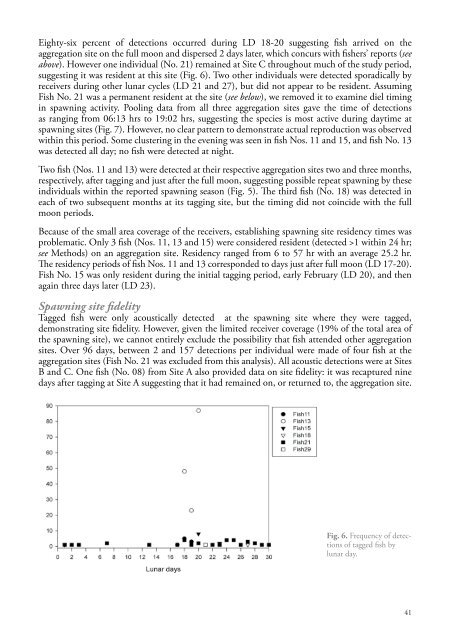WIOMSA-CORDIO spawning book Full Doc 10 oct 13.pdf
WIOMSA-CORDIO spawning book Full Doc 10 oct 13.pdf
WIOMSA-CORDIO spawning book Full Doc 10 oct 13.pdf
Create successful ePaper yourself
Turn your PDF publications into a flip-book with our unique Google optimized e-Paper software.
Eighty-six percent of detections occurred during LD 18-20 suggesting fish arrived on theaggregation site on the full moon and dispersed 2 days later, which concurs with fishers’ reports (seeabove). However one individual (No. 21) remained at Site C throughout much of the study period,suggesting it was resident at this site (Fig. 6). Two other individuals were detected sporadically byreceivers during other lunar cycles (LD 21 and 27), but did not appear to be resident. AssumingFish No. 21 was a permanent resident at the site (see below), we removed it to examine diel timingin <strong>spawning</strong> activity. Pooling data from all three aggregation sites gave the time of detectionsas ranging from 06:13 hrs to 19:02 hrs, suggesting the species is most active during daytime at<strong>spawning</strong> sites (Fig. 7). However, no clear pattern to demonstrate actual reproduction was observedwithin this period. Some clustering in the evening was seen in fish Nos. 11 and 15, and fish No. 13was detected all day; no fish were detected at night.Two fish (Nos. 11 and 13) were detected at their respective aggregation sites two and three months,respectively, after tagging and just after the full moon, suggesting possible repeat <strong>spawning</strong> by theseindividuals within the reported <strong>spawning</strong> season (Fig. 5). The third fish (No. 18) was detected ineach of two subsequent months at its tagging site, but the timing did not coincide with the fullmoon periods.Because of the small area coverage of the receivers, establishing <strong>spawning</strong> site residency times wasproblematic. Only 3 fish (Nos. 11, 13 and 15) were considered resident (detected >1 within 24 hr;see Methods) on an aggregation site. Residency ranged from 6 to 57 hr with an average 25.2 hr.The residency periods of fish Nos. 11 and 13 corresponded to days just after full moon (LD 17-20).Fish No. 15 was only resident during the initial tagging period, early February (LD 20), and thenagain three days later (LD 23).Spawning site fidelityTagged fish were only acoustically detected at the <strong>spawning</strong> site where they were tagged,demonstrating site fidelity. However, given the limited receiver coverage (19% of the total area ofthe <strong>spawning</strong> site), we cannot entirely exclude the possibility that fish attended other aggregationsites. Over 96 days, between 2 and 157 detections per individual were made of four fish at theaggregation sites (Fish No. 21 was excluded from this analysis). All acoustic detections were at SitesB and C. One fish (No. 08) from Site A also provided data on site fidelity: it was recaptured ninedays after tagging at Site A suggesting that it had remained on, or returned to, the aggregation site.Fig. 6. Frequency of detectionsof tagged fish bylunar day.41


















